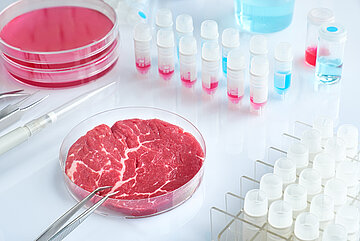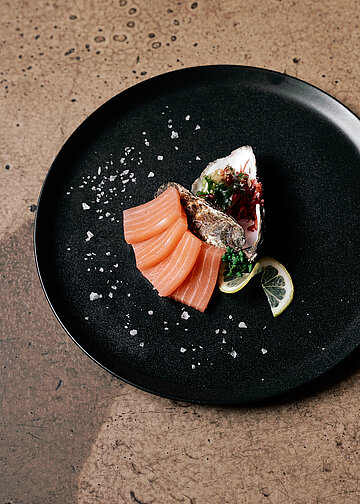The Future of Proteins
Plantarianism on the rise
One of the key developments is the increased interest in plantarianism – a diet with greater focus on plant-based options. Veganism, vegetarianism and flexitarianism are becoming ever more relevant due to a variety of factors including animal welfare, sustainability and health.
Plantarianism is creating greater demand for high-quality vegan and vegetarian protein alternatives, which aim to fully match the original in their effect on all the senses.
Reasons and motivations for new protein sources
Animal welfare and sustainability: increasing awareness of animal welfare and the significant carbon footprint of meat consumption have led to a growing interest in alternative protein sources. Overfishing of the oceans and the fact that ever more species are threatened with extinction have increased the pressure to find more sustainable alternatives. All this is reflected in the growing importance of the ‘planetary health diet’, which views the health of the planet as an integral part of human health.
Health orientation: this factor combined with increased quality awareness is driving the search for new protein sources. In view of the overpopulation of the earth and the insufficient supply of animal proteins for all people, the hunt for holistic alternative food solutions is becoming increasingly urgent.
Diversity of protein alternatives
The variety of plant-based alternatives is steadily increasing, even if sensory challenges still need to be overcome. This growing diversity can be broadly divided into three categories:
- Plant-based alternatives
- Cell-based meat and fish
- Insects
1. Plant-based alternatives
Plant-based alternatives to meat, poultry, fish, eggs and dairy products are becoming ever more varied and sophisticated. Meat substitutes made from soya and peas have established themselves as popular base ingredients. However, new alternatives based on mushrooms, algae and fermented raw materials are also gaining in popularity. The latter in particular is becoming increasingly well-liked due to its umami flavour and increased nutrient content.
A new batch of fish alternatives is also emerging, with the range of plant-based fish, crustacean and mollusc imitations constantly increasing. Beyond that, the market for plant-based dairy products is especially dynamic.
From alternatives to mozzarella, Gouda, feta, Parmesan flakes and blue cheese to yoghurt, cream cheese and cream, purely plant-based products are taking over the market.
Egg alternatives have not been left behind, either. Purely plant-based egg imitations are made from protein-rich chickpeas. Chickpea flour is a popular ingredient in whole-egg substitutes, aquafaba (chickpea water) is used as a protein substitute, and aquafaba flakes (obtained from aquafaba) can replace egg yolk as a binding agent (e.g. as a vegan equivalent in the production of mayonnaise).
2. Cell-based products
The development of cell-based meat and fish products, also known as in vitro meat, opens up completely new possibilities. In this process, stem cells are taken from the animal, reproduced in a laboratory and processed into meat alternatives. The main products generated from lab-grown meat thus far have been mince, sausages, burger patties and chicken nuggets. When it comes to mass production, the 3D printing process will be crucial. Other innovative approaches are also being tested, such as meat and fish products based on a mixture of cultured meat or fish together with plant-based ingredients, known as hybrid 3D products.
3. Insects
Insects are an important source of protein for many people, especially in Asia, Africa and South America. In Germany, however, much of the population still has reservations about the consumption of insects. The advantages of insects are obvious: they are a superior source of protein to plants and their cultivation requires less space and conserves resources, especially in terms of energy consumption. In January 2023, buffalo worms and buffalo beetles were approved as food in the EU, opening up new possibilities for the use of insects as a source of protein. Buffalo beetle (Alphitobius diaperinus) is available frozen, as a paste, dried and in powder form.
Significance for the foodservice and hospitality market
Guests in the foodservice and hospitality market are increasingly taking health and sustainability aspects into consideration. Healthy and resource-saving options are ever more likely to find favour. Plantarianism, a more plant-oriented diet, is thus becoming increasingly prevalent.
Variety for any diet: the use of plant-based alternatives and cell-based meat or fish provides a wide range of options to cater to all dietary preferences.
Easy-to-use convenience products make life simpler and offer a solution to labour and staff shortages, especially amid a hectic catering environment.
The increasing diversity of protein alternatives opens up attractive new snack opportunities for restaurateurs, bakers and snack providers.
Summary
The world of proteins is developing dynamically due to the desire for sustainable, healthy and high-quality nutritional alternatives. The variety of plant- and cell-based protein alternatives broadens the horizons of the foodservice and hospitality market and suggests a transformative future lies ahead for it and the food industry as a whole.
INTERNORGA is the ideal platform to explore these trends and discover innovative products.





